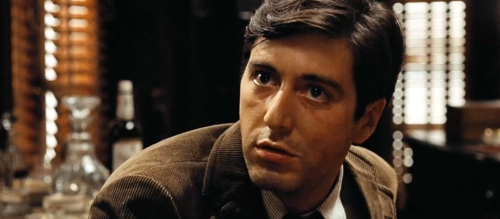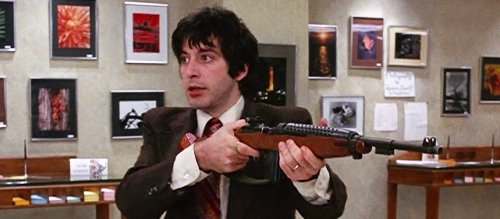Al Pacino: 3 Career-Defining Performances
New York born actor Al Pacino has given so much to cinema. Over more than fifty years, he has delivered some of the greatest performances of all time. He is so gripping, and at times so menacing, that sometimes a single stare from him can be worth as much to a film as a lengthy monologue.
After a brief appearance on screen in Me, Natalie (1969), Al Pacino caught attention for his starring role in Jerry Schatzberg’s The Panic in Needle Park (1971). The two would reteam two years later for Scarecrow (1973), where Pacino starred opposite Gene Hackman. These were two fantastic films with bleak undertones, and were an early sign that Pacino wasn’t afraid to get dirty – to shine a light on the gritty backside of 1970s USA.
Sandwiched between these two pictures was cinematic behemoth The Godfather. If Needle Park turned heads, The Godfather blew minds. Pacino was suddenly catapulted into the status of Hollywood star and was nominated for Best Supporting Actor at the 1973 Oscars. His performance as the son of mafia boss initiated his ‘tough guy’ persona, which was then further explored in Scarface (1983), Heat (1995) and The Irishman (2019). Alongside his friend Robert De Niro, he became the poster child for mobster movies. His acclaimed performances attracted iconic directors such as Sidney Lumet, William Friedkin, Brian De Palma, Michael Mann, Christopher Nolan and Martin Scorsese – a lineup that indicates one of the richest filmographies in all of Hollywood.
With nine Oscar nominations under his belt, including one win, it is difficult to highlight just three performances from this titan of cinema. But, having carefully looked over his decades-spanning career, these are the three that create the best mosaic of Pacino’s gifts as an actor – each accentuating a certain aspect of his skills. Here are The Film Magazine’s picks for Al Pacino’s 3 Career-Defining Performances.
1. The Godfather Trilogy (1972-1990)

The role that most of you will be familiar with is that of Michael Corleone in Francis Ford Coppola’s The Godfather trilogy, a sprawling epic that chronicles the rise and fall of the Corleone crime family over several decades.
Beginning with the patriarch Vito Corleone’s iron-fisted control of his empire in post-war America, the trilogy unfolds as a saga of power, loyalty and betrayal. Al Pacino plays Vito’s youngest son, the character who reluctantly steps into his father’s shoes.
Pacino’s performances across this iconic trilogy are so interwoven in creating one of cinema’s most iconic characters that it’s difficult to separate them. Michael Corleone is part of Pacino’s DNA now. It’s why Pacino walked out to the film’s love theme at his 2024 Oscars appearance – audiences see him and think ‘Michael Corleone’.
Michael’s character arc across The Godfather trilogy is one of the most compelling and transformative journeys in cinematic history. In the first film, Pacino masterfully captures Michael’s transformation from an idealistic outsider to a reluctant participant in his family’s criminal activities. His portrayal is nuanced and often understated, conveying Michael’s internal struggle. The scene in the restaurant where Michael shoots Sollozzo and McCluskey is the pivotal moment for him. Throughout the scene, Pacino’s eyes betray a mixture of fear and determination, revealing the moral battle raging within. His face tells all – this is the moment he chooses his fate. As he pulls out the gun there is something primal in his eyes and it is clear which path Michael has chosen.
Part II sees Pacino’s performance intensify, reflecting Michael’s gradual descent into darkness. He brings an added layer of complexity to the character as Michael embraces his role as the new Don and audiences witness the lengths he’ll go to in order to protect his family. Pacino doesn’t slip for a second as he carries a calculating demeanour in each scene. His portrayal goes beyond chilling. And while the film does feature some explosive moments (such as when he learns of Kay’s abortion), it is the quieter moments that fully convey his ruthlessness. The scene where Michael calmly tells Fredo he means nothing to him anymore is hauntingly bleak. The ending of Part I showed Michael becoming the bad guy, but Part II showcases the complete loss of a soul.
Part III shifts gears, and Pacino’s portrayal of an older Michael is poignant, as the character grapples with the consequences of his past actions and seeks redemption for his sins. He carries an air of regret with him, yet that darkness still bubbles underneath. This new emotional depth may seem unexpected given the ending of Part II, yet Pacino navigates it exceptionally well and with great craft.
These three performances come together to create a portrait of one of the most riveting characters in fiction. One that only an actor of Pacino’s calibre can pull off.
2. Dog Day Afternoon (1975)

Michael Corleone may be Al Pacino’s legacy, but it is only one of many brilliant performances that populate his career. In 1975, Pacino starred in Sidney Lumet’s Dog Day Afternoon, writing another exceptional portrayal into the history books. It was their second film together after the hit Serpico only two years prior. While Serpico seemed like the perfect role for Pacino – playing the serious tough guy – Dog Day Afternoon introduced the world to the zanier side of the great actor.
Dog Day Afternoon depicts the true story of a bank robbery gone awry in Brooklyn, New York. Sonny Wortzik (Pacino) and his partner Sal (fellow Godfather alum John Cazale) become embroiled in a hostage situation that captivates the media. Sonny becomes something of a celebrity as the robbery continues, winning over the hearts of the spectating public. As the film goes on, Sonny’s motivations and personal struggles come to the forefront as Lumet explores themes of desperation and identity.
Sonny is in many ways the antithesis to Michael Corleone. He is eccentric, loud and erratic. His lack of control is something Michael would scoff at. Pacino does not hold back, giving an electrifying performance. The first 10 minutes of the film are almost a screwball comedy in how Pacino races around the bank. A lesser actor could so easily mess this up by either going too far or not far enough, yet Pacino keeps it at the perfect level. Sonny rallying the crowds while chanting “Attica,” (in reference to police brutality in America) makes it easy to be swept up by him. Despite being a criminal, Pacino brings so much likability to the role – his earnest performance makes the police look like nothing more than party poopers.
For all his peculiarities, once Sonny is stripped back he is a much deeper character than one would initially assume. Pacino delivers an honest and at times heartbreaking performance that ensures this hits home. One scene worthy of highlight is the phone call between Sonny and Leon. Pacino shows a vulnerability that he hadn’t fully explored before. Suddenly, this deeply flawed character becomes sympathetic, Pacino masterfully giving humanity to a character who could easily be written off as a villainous criminal.
Dog Day Afternoon was a defining moment in Pacino’s career. Often regarded as one of the best heist films, it rests solely on its lead’s shoulders. Had that central performance not been as charismatic and as endearing as it was, it is wholly possible the film wouldn’t have attracted the audience it did. Add to that the task of playing a real person and it is clear that, with only a few films under his belt, Pacino had become a generational talent.
3. Heat (1995)

A lot of people see the 1990s as a renaissance for Al Pacino’s career. Although the 80s saw successful roles, such as Tony Montana in Scarface and the underrated William Friedkin picture, Cruising, the critically-panned Revolution in 1985 resulted in Pacino taking a four year hiatus from cinema. He returned in a big way, starring in fourteen films across the 1990s. The decade features some of the actor’s biggest hitters, such as the aforementioned Godfather Part III, Glengarry Glen Ross, Carlito’s Way, Donnie Brasco, The Insider and, to date, Pacino’s only Oscar win for Scent of a Woman. But the final choice on this list is Michael Mann’s Heat.
Heat follows the intersecting lives of Neil McCauley (Robert De Niro), a skilled thief leading a crew of professional criminals, and Vincent Hanna (Al Pacino), an LAPD detective. As McCauley plans a series of heists, Hanna becomes increasingly obsessed with catching him, leading to a tense game of cat and mouse. Heat was (and still is) seen as a big deal for its cast alone – while Pacino and De Niro had both appeared in The Godfather Part II, this was the first time they had ever actually shared the screen.
Here, Pacino plays someone on the other side of the law to the roles he made his name with, and yet he still brings the same bravado and intensity that he always did. His portrayal of desperation infuses the script with urgency, and much like his previously commanding roles, there is so much more going on with the character than first meets the eye. His failing marriage creates a sense of isolation, and his obsession with McCauley therefore makes more sense, as it allows him to focus his energy elsewhere. It’s a difficult character to get right, but Pacino nails it.
The best scene sees Hanna and McCauley finally meet over coffee. The two characters share a rare moment of connection amidst their rivalry. The chemistry between Pacino and De Niro fills the frame, as well as the simmering tension that builds throughout their conversation. A verbal duel ensues, exchanging cryptic words that hints at their shared understanding of the high-stakes game they’re a part of. The weight of the film rests on this scene and Pacino carefully delivers the sharp dialogue in a way that seems natural and aware of the scene’s narrative heft. Despite being on opposite sides of the law, there’s a mutual recognition and admiration between the pair, as they share a code of honor and professionalism. This can be summed up with a brief smile Pacino shoots De Niro’s way. It’s a touching scene featuring two legends at the top of their game.
Recommended for you: More Career-Defining Performances Guides
Throughout this article, there has been reference to countless other performances by Al Pacino. That is because the primary three highlighted here represent merely a fraction of the greatness that occupies Pacino’s oeuvre. Most actors would dream to be known for one iconic role, but Pacino has at least four under his belt. Al Pacino is an actor who always brings it, who makes any bad film infinitely more watchable with his larger than life presence. Simply put, he is one of our greatest talents.

